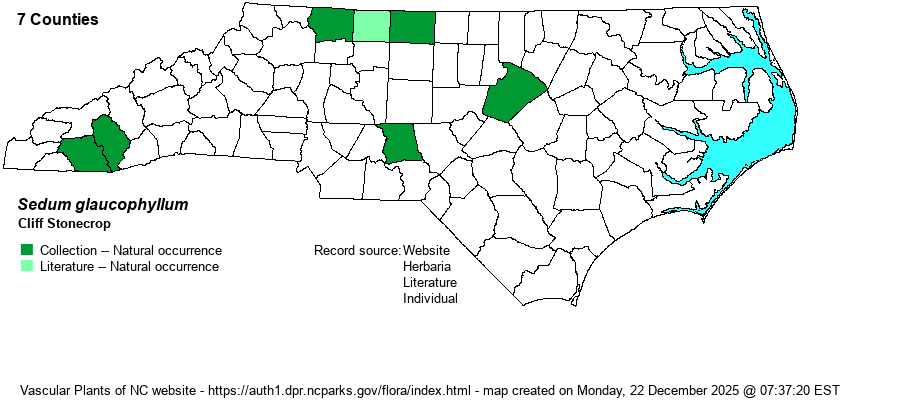| Author | Clausen | |
| Distribution | Widely scattered over the Mountains and Piedmont, but most frequent in the northwestern Piedmont. Ranges east to Wake (formerly) and Montgomery counties. The specimen allegedly from Alleghany County is actually from Alleghany County, VA. The record from Surry County is unsupported by a specimen at SERNEC.
This is a range-restricted species, found from western MD south to NC, with the great bulk of the records in the western half of VA. Known only from four states -- MD, WV, VA, and NC. | |
| Abundance | Rare in the northwestern Piedmont, and very rare at a few spots in the Mountains and southeastern Piedmont. This is a Significantly Rare species. | |
| Habitat | This species is restricted to rocky habitats. It grows only in circumneutral soil, on mafic, calcareous, or sedimentary rocks (like shale) with moderately high pH soil. Thus, it is absent in the much more common acidic rock outcrops. It is found on cliffs, rocky slopes, and cracks in other rock faces. |
| Phenology | Blooms in May and June, and fruits in June and July. | |
| Identification | This is a low-growing herb, typically branched at the base and decumbent or spreading, with glaucous (pale blue-green) foliage. The numerous, crowded, alternate leaves are narrowly oblong to spatulate, about 2/3-inch long but only 1/5-inch wide. At the ends of the branches are elongated flower clusters, in cymes. The 4 petals are white and narrow, with the spread flower about 1/3-inch across. S. ternatum is rather similar in growth form, but its leaves are primarily in whorls of 3-4 leaves. S. pusillum is an erect species of granitic flatrocks, with shorter and more elliptical leaves. When a group of S. glaucophyllum plants is seen on a rock face or outcrop, you should notice the horizontal/spreading look to the plants, which barely reach 3-4 inches tall but are much wider. | |
| Taxonomic Comments | This species was included in many or most earlier references into S. nevii, but botanists split out this species from S. nevii (strict sense), which is a more South-central species (TN, GA, and AL).
| |
| Other Common Name(s) | None | |
| State Rank | S2 | |
| Global Rank | G4 | |
| State Status | SR-P | |
| US Status | | |
| USACE-agcp | | |
| USACE-emp | | |

